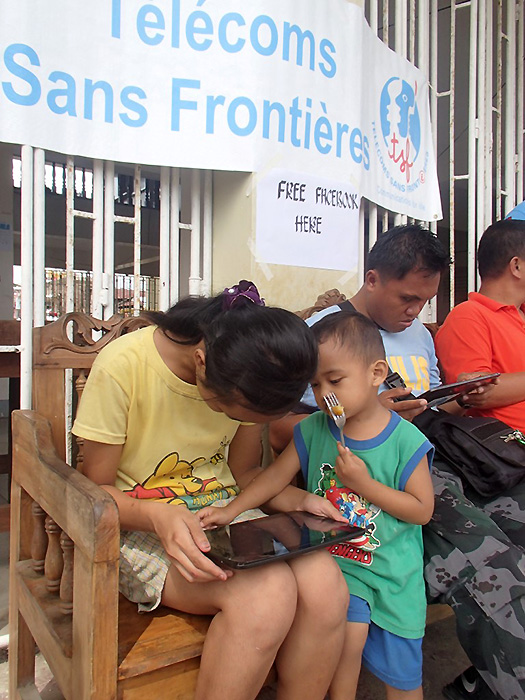Typhoon Hagupit
Context: Typhoon Hagupit
Start date: 07/12/2014
End date: 21/12/2014
Areas of intervention: Eastern Samar
Activities:
- Telecoms assessments
- Support to coordination
- Humanitarian Internet Centre
3 Internet centres
7 organisations supported
1,957 GB of data exchanged for coordination
Context
On 7th December, the Philippine archipelago was hit by the most powerful typhoon of 2014. Ranked in category 5, Hagupit (meaning “strike” in Tagalog – locally known as Ruby) moved slowly across the country, causing significant damages.
Torrential rains and winds of more than 200 km/h caused floods and landslides. Power lines were torn down and hundreds of homes were destroyed, leaving entire families bereft in the most affected provinces of Eastern Samar and Masbate.
According to the Philippine Red Cross, 1.2 million people were gathered in 1,500 makeshift shelters in churches, gymnasiums or schools.
Deployment
Following the predictions of Super Typhoon Hagupit, Télécoms Sans Frontières deployed in Manila, the capital, a team from its Asia-Pacific regional base and from its headquarters, to support the numerous relief teams and NGOs in the field, as well as the thousands of civilians affected.
Telecoms assessments
Upon arrival, TSF worked directly with the United Nations Disaster Assessment and Coordination team (UNDAC) on sharing and gathering as much information as possible on the affected zones. TSF provided satellite communications support to the UNDAC assessment teams in their field evaluations, allowing for better coordination and information flow between field teams, UN regional offices and UN agencies.
Alongside numerous iNGOs, TSF worked with the Humanitarian Country Team (HCT) for the Philippines to define the areas requiring humanitarian aid. TSF also collaborated with local operator SMART to identify the most heavily impacted telecommunications infrastructures.
The province of Eastern Samar was drastically weakened and vastly destroyed by the passage of Typhoon Hagupit. Following rigorous assessments of the towns spanning from Borongan to Artechi (Eastern Samar), TSF confirmed that local network operators had mostly re-established mobile networks; however access to internet remained a problem, the lack of which was preventing municipalities from coordinating their operations amongst the families in these isolated and impoverished communities.
Support to coordination
To meet this need, TSF positioned mobile satellite connections in the town hall and hospital of Dolores (46,000 inhabitants), as well as in the municipalities of Oras (38,130 inhabitants) and in Borongan – three of the worst-hit towns in the province.
“Your vital connection allows us to send and receive damage assessment reports to and from other municipalities and NGOs such as yourself – this is so important so we know what the needs are and where they lie. Your big hearts and even bigger help mean that my town council can bring help to my people”, testified the Mayor of Dolores.
These connections also served the NGOs that used council buildings as field offices, including World Vision, Save the Children and Islamic relief. Thanks to TSF, these organisations had at their disposal a coordination centre where they could share reports and assessments between head offices, field teams and working groups.
Dedicated to assisting its fellow NGOs, TSF put in place a fixed satellite connection in the office of Plan International Philippines, which has a permanent centre in Borogan since Typhoon Haiyan in 2013.
Humanitarian Internet Centre
Following Hagupit, the townspeople of Dolores were not able to access a means to get news of their friends and families in the towns spread across the region of Eastern Samar. TSF continued to enhance its support to Dolores by providing free high-speed internet access with tablets to the population in its HICC (Humanitarian Internet Communications Centre).
The centre allowed affected population to access to Facebook, emails, news sites and other platforms where they can get information about the aftermath of Hagupit.
In some cases, this was the first time people had been able to contact their loved ones since Hagupit struck.
















